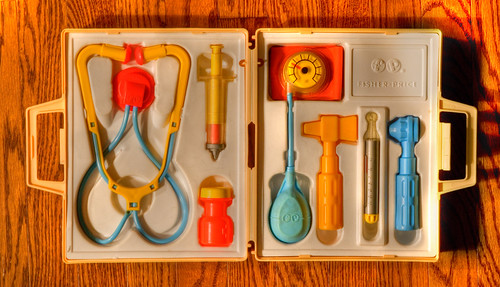Now for the under-the-hood version, for those interested in the details:
Both versions of the Sparrow are mounted through two 4-40 size, grounded screw holes. No need to worry about insulating spacers or conductive sleds.
You can set the main chute altitude in the field with a simple rotary switch, in 100 foot increments up to 1500 feet. If you ever want to know what the main chute deployment altitude is set to, no need to power it on or look up jumper settings, just read the number indicated on the dial. The switch is a 16-position DIP switch labeled 0-9 then A-F. 1 is 100 feet, 9 is 900 feet, A is 1000 feet, F is 1500 feet, etc. I'm not yet sure what's the best use for the 0 setting; for now it will also just fire at 100 feet.
When you power it up, there is an immediate beep, followed by a beep-out of the battery voltage in 10ths of a volt.
Then it beeps out the continuity status of the 2 channels. A high beep and a green LED indicates the channel has continuity. A long, lower beep and a red LED flash indicates no continuity for that channel. (Just like the Raven, but with 2 channels instead of 4, and with color-coded LEDs for clarity) The altimeter is ready for launch. The altimeter uses a piezo buzzer that consumes much, much less power than the one used on the Raven, significantly improving the battery life. I'm not sure yet how long it can hang out at the pad with the smallest batteries, but it will be many hours.
The pad altitude is updated continuously, with enough time lag so that even a very slow launch won't be mistaken for a change in pad altitude. The altitude used for liftoff detection is filtered so that a transient from the rocket being dropped, etc. won't be mistaken for liftoff. Several seconds of data is continuously buffered so that all of the flight is recorded, even for a slow liftoff that delays the liftoff detection.
After liftoff, the altimeter records at 20 Hz the raw baro pressure in 1/25000 of an atm, temperature with 0.2F resolution, battery voltage, apogee channel voltage, and main chute voltage with 15 mV resolution. Also recorded is a digital flight events register that includes all of the flight event states that are used for deployment decisions (liftoff detection, velocity check status, apogee detection, altitude < main chute setpoint, and which channels fired). Velocity and other derived measurements that are calculated for use on board and can be reconstructed after the flight are omitted from the recording to maximize space. The Sparrow also records the pad altitude and flight number (odometer reading) in a 1-time slot at the start of the flight.
During the flight, the altimeter uses a combination of filters so than any spurious barometric data spikes are thrown out, and then the validated data is smoothed from there. Velocity is calculated and smoothed again before it is used, so that it's reliable for the deployment logic. Both channels are set to check that the vertical velocity is well under the level at which Mach effects can affect the data, for at least 2 seconds. When the rocket starts to descend, the apogee charge fires for 1 second. When the rocket descends through the main altitude set with the dial switch, the main chute fires for 1 second. When the rocket lands and the vertical velocity goes to zero, the data stops recording and the Sparrow starts beeping out the maximum altitude.
There is the same large, on-board capacitor to keep the altimeter running during deployment firings that the Raven uses. Since the Sparrow takes even less power, it will stay up even longer without any power input. So if you have a hard short that makes the battery voltage to go zero for either or both deployment outputs, the Sparrow will keep on humming throughout the event. The FETs are each rated for over 25 Amps continuous, so people who choose to use relatively large lipo batteries for the Sparrow XS don't have to worry about burning out a FET.
Power cycle the Sparrow and it's ready to go again. It will automatically save the most recent 5 flights worth of data, erasing the oldest flight as needed so that it's always ready to go. If a single flight takes longer than 40 minutes, and if the memory for the next flight has been cleared, the recording will continue into the next flight slot. A flight up to 3.4 hours can be recorded this way. To free up contiguous slots for a long flight (like a balloon flight, for example) you can erase any or all of the 5 flight slots with the computer interface. The Featherweight Interface Program will be updated to perform all of the interface functions for the Sparrow, and will provide derived data such as altitude and velocity.








